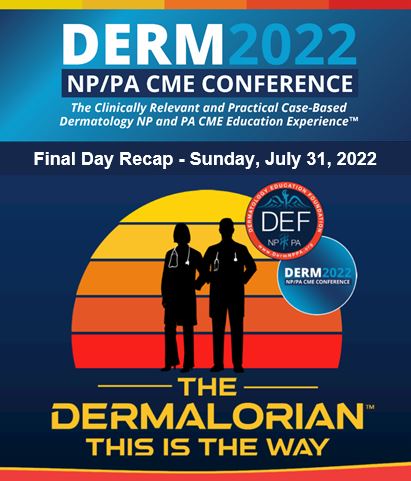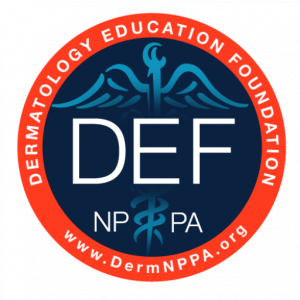

Highlights from Today’s CME Presentations:
Tips and Tricks for Counseling Patients with Julie Harper
Have you ever wanted to spend a day with an amazing dermatologist to hear all her tricks and tools? Today in general session we had just that opportunity when Dr. Julie Harper gave us her best pieces of wisdom! She began with a reminder to love our work. She discussed getting in the right frame of mind by beginning our clinic days with gratitude and even stressed to love our patients. If we’re focused on our patients, every patient every time, we give them our full attention and best care. She suggested having an open dialogue with patients during exam visits. “Did I miss anything that is bothering you?” In addition, she completes her visits with a brief summary for repetition purposes. We must ask our patients about sunscreen use. If we don’t ask them about sunscreen, who will? She suggested tailoring our sunscreen recommendations to each patient to improve compliance.
Dr. Harper gave a staunch reminder to treat our acne patients to clear skin. We must help our patients to have realistic expectations. However, we must utilize therapy from our treatment armamentarium to be as aggressive as required for clear skin. She gave a brief discussion of oral antibiotics, spironolactone, oral contraceptive, and isotretinoin use for patients with acne vulgaris. She reminded us of her STOP algorithm for managing rosacea where S stands for (identify) Signs and symptoms of rosacea, T reminds us to (discuss) Triggers, O stands for (agree on an) Outcome, and P (develop a) Plan. She shared a hand-written sketch of the layers of skin and involvement of melanoma in situ and her best pearls of wisdom for Botox use and administration, realistic outcomes for patients with alopecia, as well as strategies to treat patients with allergic contact dermatitis.
Dr. Harper ended her discussion with consideration of using EGN “extra grace needed.” She suggested to consider using this tag on patient’s charts where required but reminded us all that we have bad days sometimes. Give grace even to yourself today compliments of the legendary Dr. Julie Harper!
Ten Cases in Ten Minutes with David Cohen
Oh, how we love cases with pictures in the field of dermatology! Dr. David Cohen showed off his skills today and shared 10 dermatology patients cases this morning. He began by reminding us of paradoxical head and neck erythema on patients being treated with Dupixent (dupilumab). When you see this in practice, Dr. Cohen recommended use of topical corticosteroids, topical calcineurin inhibitors, antifungal agents, as well as reducing the frequency of administration of Dupixent (dupilumab). We might also consider patch testing these patients for comorbid contact allergies. Don’t forget the newer therapies such as Eucrisa (crisaborale) or Opzelura (ruxolitinib) with this entity!
Our next case involved a patient with new-onset rash who had a rash highly consistent with allergic contact dermatitis. Patch testing this patient revealed a significant disperse dye allergy—yes, she reacted to her favorite sweatshirt!? In true Dr. David Cohen fashion, he wowed us with a challenging 85-year-old patient including images of a significant pruritic rash involving trunk, palms, and soles. Marked hyperkeratosis on his palms and soles challenged our ability to identify this patient’s diagnosis. The patient was patch tested and histopathology revealed our favorite: spongiotic dermatitis. The patient was started on Dupixent (dupilumab) and acitretin for marked improvement and clearance of rash. What a great case, Dr. Cohen!
Next, Dr. Cohen presented a case involving a 20-year-old male with history of eczema since childhood with current, pruritic rash involving his neck, upper back, and chest. Patch testing revealed this gentleman had multiple, common, contact allergies. Dr. Cohen reminded us how to handle biologic use in patients who require surgery and suggested co-management and reminded us that most patients undergoing surgery can stay on their biologic therapy unless there is a high-risk surgery required. Next, he shared images of a 56-year-old female with long-term history of psoriasis and mild, arthropathy. She was challenging due to her prior biologic exposure with treatment failure including Enbrel (etanercept), Humira (adalimumab), Cosentyx (secukinumab), Taltz (ixekizumab), and Tremfya (guselkumab). After 6 months of therapy with Skyrizi (risankizumab), her rash was markedly improved.
Additionally, Dr. Cohen presented a 43-year-old male with psoriasis and psoriatic arthritis who had previously tried and failed Cimzia (certolizumab pegol), Taltz (ixekizumab), Cosentyx (secukinumab), Stelara (ustekinumab), Skyrizi (risankizumab), Tremfya (guselkumab), Humira (adalimumab), Methotrexate, Enbrel (etanercept), sulfasalazine, phototherapy, topical corticosteroids, Intra-Lesional Kenalog, coal tar, and Xeljanz (tofacitinib). This gentleman only cleared on systemic therapy with Siliq (brodalumab) and Otezla (apremilast) dual-therapy. However, due to insurance issues, this therapy combination was difficult to maintain.
He shared a case of a 32-year-old with history of atopic dermatitis since infancy who failed to respond to therapy with azathioprine, methotrexate, mycophenolate at high dose, IVIG, phototherapy, Xeljanz (tofacininib), Dupixent (dupilumab) combination therapy with cyclosporine, and Rinvoq (upadacitinib). After further evaluation, the patient underwent therapy with Adbry (tralokinumab) for skin clearance reminding us to consider in-class switching of our therapies for atopic dermatitis. Another female patient with recalcitrant atopic dermatitis despite therapy with Dupixent (dupilumab) was imitated on Rinvoq (upadacitinib) for improvement but also had co-morbid urticaria. Dr. Cohen’s advice for these patient challenges was to treat what we can with the best available data. For this patient, Rinvoq (upadacitinib) was discontinued, and she was re-initiated on systemic therapy with Dupixent (dupilumab) for complete clearance of her atopic dermatitis and urticaria. Thank you, Dr. Cohen for sharing such great patient cases!
New Innovations in Hyperpigmentation with Suneel Chilukuri
Dr. Sunil Chilukuri began his talk on innovations in hyperpigmentation by reminding us about the psychological effect of disorders of pigmentation. He briefly discussed the pathophysiology of melanogenesis and the morphology of hyperpigmentation for our review.
Dr. Chilukuri presented a new sunscreen product created by Skin Medica called Total Defense & Repair. This product defends against harmful infrared radiation and protects against the damaging effects of UVA/UVB all while rejuvenating photodamaged skin. He presented the Return to Calm CBD Mask developed by ClarityRX. This product is rich in omega fatty acids, vitamin E, and protein and seems to have some anti-inflammatory properties as well as moisturization. He reminded us of the gaps in care with traditional therapies for hyperpigmentation. Enter a newly developed product containing cysteamine. In the past, the intense odor prohibited its use in topical products (fishy, fishy). Despite this, in in-vitro studies, cysteamine demonstrates an 80% reduction in melanin synthesis and is a potent antioxidant. Dr. Chilukuri shared images of a patient who failed to respond after 4 years of continuous Kligman’s formula (5% hydroquinone, 0.1% dexamethasone, and 0.05% retinoic acid). This patient improved after 15 weeks of cysteamine monotherapy and treatment response was maintained after 5 years with twice weekly cysteamine weekly dosing.
But wait, I want more! A new product called Cysteamine Catalytic Complex is under development by Cyspera. This product contains an isobionic-amide which is a melanosomal transfer inhibitor. When combined with cysteamine and Alpha Hydroxy Acid, the depigmenting efficacy magnifies. Use of this product demonstrates immediate reaction-leading to an instant, visible, and reversible pigment lightening in the corneal layer of the skin. Dr. Chilukuri shared evidence from a double-blind, randomized placebo- and positive-controlled study to investigate the safety, tolerability, and efficacy of a new regimen with cysteamine- and non-cysteamine based products in the treatment of melasma presented in 2021 in MS Clinical Research. Results of this study revealed a significant difference between both cysteamine and Triluma and placebo at week 4 as well as no significant difference noted between cysteamine and Triluma at week 4. When we consider the side effects of these therapies, we may soon have a new, safer treatment option for treating melasma and disorders of hyperpigmentation.
Dr. Chilukuri also shared common ingredients to treat hyperpigmentation in chemical peels. Alpha-Hydroxy, Beta-Hydroxy, and Retinoic Acids including glycolic, lactic, and malic may be useful in all skin types for treating pigmentation, rosacea, and acne. In addition, Trichloroacetic Acid (TCA) at concentrations of 6-20% can be used in patients with Fitzpatrick skin types I-VI whereas concentrations of 20-50% should only be used in Fitzpatrick skin types I-III. A new chemical peel created and developed by ClarityRX utilizes 10% Lactic Acid and gently exfoliates while improving rough texture associated with actinic damage. LASER therapies can also be used to treat disorders of hyperpigmentation. The Nd:YAG (1064 nm) plus 650-microsecond Technology may become the most ideal LASER for treating these disorders. LASER technologies and chemical peels and topical combination therapies can be used together for comprehensive in-office and at-home treatment. Radiofrequency is also being studied for skin rejuvenation, tightening, lifting, and scar treatment.
Dr. Chilukuri ended his discussion with a reminder to insist on sunscreen use in all patients with disorders of hyperpigmentation.
Scientific Poster of the Day
POSTER NUMBER: 10
TITLE: Tapinarof Cream 1% Once Daily for the Treatment of Moderate to Severe Atopic Dermatitis in Children and Adults: The Pivotal Phase 3 ADORING Clinical Program
AUTHORS & AFFILIATIONS:
Lawrence F. Eichenfield, MD,1,2 Jonathan I. Silverberg, MD, PhD, MPH,3 Robert Bissonnette, MD,4 Anna M. Tallman, PharmD,5 Philip M. Brown, MD,5 David S. Rubenstein, MD, PhD,5 Stephen C. Piscitelli, PharmD,5 John E. Jett, PhD5
1School of Medicine, University of California, San Diego, CA, USA; 2Rady Children’s Hospital, San Diego, CA, USA; 3School of Medicine and Health Sciences, The George Washington University, DC, USA; 4Innovaderm Research Inc., Montreal, QC, Canada; 5Dermavant Sciences, Inc., Morrisville, NC, USA
ABSTRACT:
Introduction: There is a need for efficacious non-steroidal topical therapies for atopic dermatitis (AD) without restrictions on duration, extent of use, or application site. Tapinarof is a novel therapeutic aryl hydrocarbon receptor modulating agent (TAMA) in development for the treatment of psoriasis and AD. In a 12-week Phase 2b study, tapinarof cream 1% once daily (QD) demonstrated significant efficacy versus vehicle and was well tolerated in adolescents and adult patients with moderate to severe AD. Furthermore, efficacy was generally maintained through the last study visit, 4 weeks after completing treatment, warranting further investigation of a potential remittive effect. The efficacy and safety of tapinarof cream 1% QD is being assessed in children and adults with moderate to severe AD in two pivotal Phase 3 studies (ADORING 1 and 2) and a long-term extension Phase 3 study (ADORING 3).
Studies: ADORING 1 and 2 are two identical, Phase 3, multicenter, double-blind, vehicle-controlled, randomized studies. Male or female patients aged ≥2 years, with a clinical diagnosis of AD, a validated Investigator Global Assessment for Atopic Dermatitis™ (vIGA AD) score >3, and body surface area (BSA) involvement ≥5% and ≤35% (excluding the scalp) are randomized 2:1 to tapinarof cream 1% or vehicle cream QD for 8 weeks. The primary efficacy endpoint of ADORING 1 and 2 is the proportion of patients with a vIGA AD score of clear (0) or almost clear (1) and ≥2-grade improvement from baseline to Week 8. Additional efficacy endpoints include assessments on Eczema Area Severity Index, %BSA affected, and Peak Pruritus-Numeric Rating Scale scores from baseline to Week 8.
Patients who complete ADORING 1 or 2 will have the option to enroll in the 48-week, open-label, long-term extension study, ADORING 3. In ADORING 3, patients entering with vIGA AD score ≥1 receive tapinarof until complete disease clearance (vIGA AD=0). Patients entering with, or achieving, vIGA AD=0 discontinue treatment and are monitored for duration of remittive effect: off-therapy maintenance of vIGA AD score of clear (0) or almost clear (1). Patients with disease worsening (vIGA AD ≥2) are re-treated with tapinarof until vIGA AD=0. Across all studies, safety assessments include adverse events and patient- and investigator-rated local tolerability.
Conclusions: This comprehensive Phase 3 clinical trial program assesses the efficacy, safety, tolerability, durability, and potential remittive effect of tapinarof cream 1% QD for the treatment of children and adults with moderate to severe AD.
SPONSOR: Dermavant Sciences
